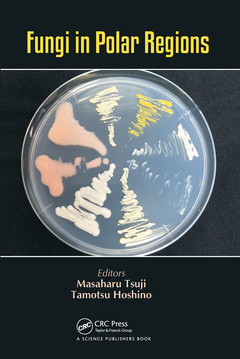Description
Fungi in Polar Regions
Language: English
Keywords
PowerSoil DNA Isolation Kit; DNA Sequence Information; Antarctica; Ethanol Fermentation; Arctic; DNA Barcoding; psychrophilic microbes; Cell Death Ratio; cold adapted fungi; D2 Region; cold-like microbes; Moss Tissues; adaptation to extreme environments; Syowa Station; mycoflora; King George Island; Spitsbergen Island; Incertae Sedis; Snow Molds; Bod Removal Rate; Fungal OTUs; Maritime Antarctica; Snow Mold Fungi; Antarctic Moss; Fungal Succession; Salix Polaris; Bryum Pseudotriquetrum; Vascular Plants; Sake Yeast; Basidiomycetous Yeast; Fungal Assemblages; Hyphal Length
Publication date: 03-2021
· 15.6x23.4 cm · Paperback
Publication date: 05-2019
· 15.6x23.4 cm · Hardback
Description
/li>Contents
/li>Biography
/li>
Fungi that inhabit polar-region can grow and decompose organic compounds under subzero temperatures play important roles in the nutrient cycle of polar-region ecosystems. Thus, changes in the mycoflora affect the ecological recycling in these regions, and understanding the cold-adaptation strategies of fungi under extreme environments is critical for a better understanding of polar-region ecosystems. Due to their ability to survive under extreme environments, fungi in polar-region are seen to show potential for utilization in biotechnologies. This book presents our current understanding of the mycoflora in polar-region and their cold adaptation strategies, and applied studies using their abilities.
TABLE OF CONTENTS
An Index of Non-lichenized Fungi Recorded in the Vicinity of Syowa Station, East Antarctica
Masaharu Tsuji
Diversity and Ecology of Fungi in Polar Region: Comparisons between Arctic and Antarctic Plant Remains
Takashi Osono, Shunsuke Matsuoka, Satoru Hobara, Dai Hirose and Masaki Uchida
Snow Molds and their Antagonistic Microbes in Polar Regions
Tamotsu Hoshino, Hisahiro Morita, Yuka Yajima, Masaharu Tsuji, Motoaki Tojo and Oleg B. Tkacehnko
Pathogenic Fungi on Vascular Plants in the Arctic: Diversity, Adaptation, Effect on Host and Ecosystem, and Response to Climate Change
Shota Masumoto
DNA Metabarcoding for Fungal Diversity Investigation in Polar Regions
Shunsuke Matsuoka, Yoriko Sugiyama and Hideyuki Doi
Oomycetes in Polar Regions
Motoaki Tojo
Biotechnological Potentials of Arctic Fungi
Purnima Singh and R. Kanchana
Dairy Wastewater Treatment under Low-Temperature condition by an Antarctic Basidiomycetous Yeast
Masaharu Tsuji, Sakae Kudoh and Tamotsu Hoshino
Ethanol Fermentation by the Basidiomycetous Yeast Mrakia blollopis Under Low Temperature Conditions
Masaharu Tsuji and Tamotsu Hoshino
Masaharu Tsuji worked at the Hokkaido center, National Institute of Advanced Industrial Science and Technology as a technical staff member with Dr. Tamotsu Hoshino in 2009. He was awarded the Ph.D. degree in Agriculture from Iwate University, Japan, in March 2015. In April 2015, he joined the Biology group, National Institute of Polar Research as a Project Researcher. His current research interests include mycoflora in Polar region, cold adaptation strategies for them and utilization of their potential for biotechnology.
Tamotsu Hoshino received Ph.D. in fungal biotechnology from Graduate School of Agriculture, Nagoya University in 1992. He has developed ecophysiological characteristics of fungal cold adaptation from snow molds in the Arctic to Antarctica via Siberia. His research interests include cold adaptation of fungi from molecular to ecological level, speciation of fungi in cold environments and effects of climate change on cold-adapted fungi. He was a Board Member of Trustees of Mycological Society of Japan (2013-2016).




